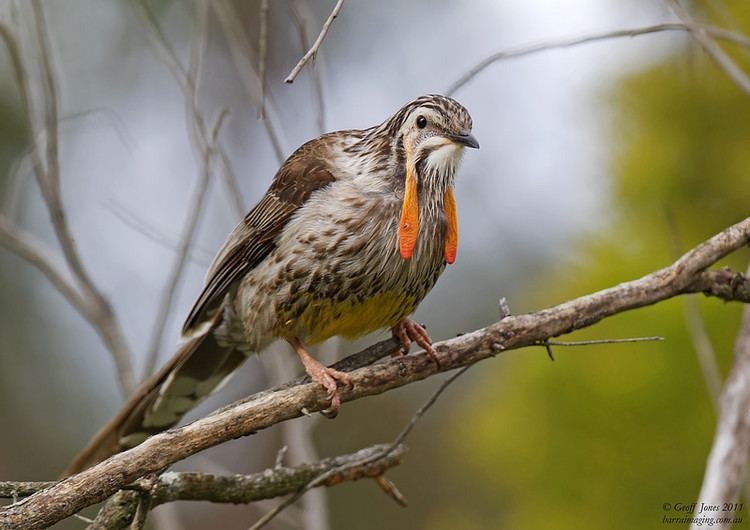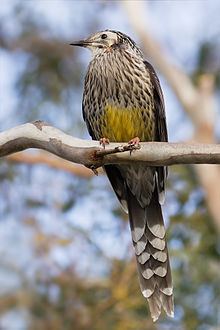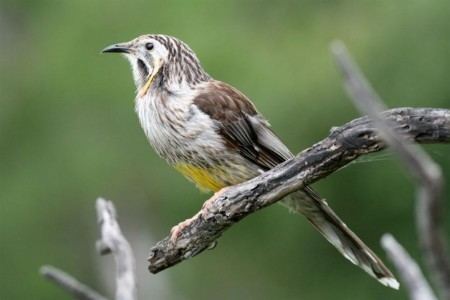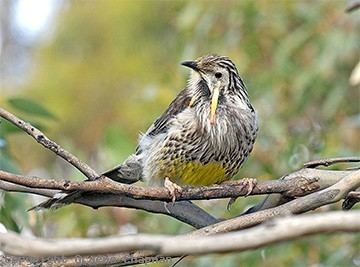Order Passeriformes Genus Anthochaera Higher classification Wattlebird | Phylum Chordata Family Meliphagidae Scientific name Anthochaera paradoxa Rank Species | |
 | ||
Similar Wattlebird, Bird, Yellow‑throated honeyeater, Honeyeater, Strong‑billed honeyeater | ||
Yellow wattlebird
The yellow wattlebird (Anthochaera paradoxa) is a species of bird in the family Meliphagidae. Other names include the long or Tasmanian wattlebird.
Contents

Yellow wattlebird
Taxonomy
French zoologist François Marie Daudin described the yellow wattlebird in 1800 as Corvus paradoxus.
Description

The yellow wattlebird is the largest of the honeyeaters, and is endemic to Tasmania. They are usually 375–450 millimetres (15–18 in) long. They are named for the wattles in the corners of their mouths. Yellow wattlebirds are slim birds with a short, strong bill. They are dark-coloured forest birds that somewhat resemble slandering grackles. They have a white face and black-streaked crown. They also have a long, pendulous yellow-orange wattle. The wattle becomes brighter during the breeding season. They have dark wings and a yellow belly, whereas the upperparts are grey to dusky brown. The female yellow wattlebird is much smaller than the male. The young yellow wattlebirds have much smaller wattles, a paler head and a browner underbelly than the adult birds. Yellow wattlebirds are active and acrobatic with a strong flight. They are fairly tame birds and often enter gardens looking for food.
The yellow wattlebird is similar in appearance to the little wattlebird and the red wattlebird.
Voice
Harsh, raucous, often been compared to a person coughing or vomiting.
Breeding

Yellow wattlebirds nest in breeding pairs and aggressively defend their territories from other birds. The nest of the yellow wattlebird is made by the female alone, and is a large, open saucer-shaped structure made of twigs and bark that are bound by wool. The inside of the nest is lined with wool and grass. The nests can be up to 13 centimetres (5.1 in) high and are found in trees or shrubs. Yellow wattlebirds lay 2–3 eggs that are salmon-red, spotted and blotched red-brown, purplish red and blue-grey. Both the males and females incubate the egg and feed the young.
Habitat

Yellow wattlebirds live in a variety of habitats including both dry and wet forests and from sea level to the subalpine zone. They live in coastal heaths, forests and gardens near Eucalyptus trees. They also can be found in mountain shrubberies and open woodlands, particularly those dominated by Banksia. They have also been known to be found on golf courses, orchards, parks and gardens.
Range

Yellow wattlebirds are common in Tasmania, especially in the eastern and central areas. They are also found on King Island and two sightings have been recorded on the southern Mornington Peninsula in Victoria.
Ecology

Yellow wattlebirds feed on the nectar of eucalypts and banksias, fruit, insects, spiders, honeydew and manna (crystallised plant sap). They forage from all levels of the canopy from the ground to the top of the trees. However, the blossoming of eucalyptus trees can be highly irregular in time and place causing considerable changes from year to year in the breeding distribution of yellow wattlebirds, which rely on the nectar from the eucalyptus trees as a main source of food. Therefore, the most likely threat to the yellow wattlebird is unusual climatic conditions that can reduce food availability suddenly. Yellow wattlebirds can pollinate eucalyptus trees by carrying pollen in their bills or on the feathers of their heads.
